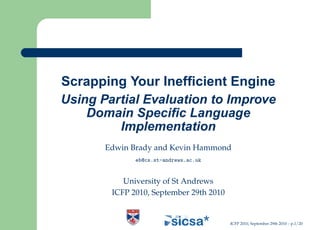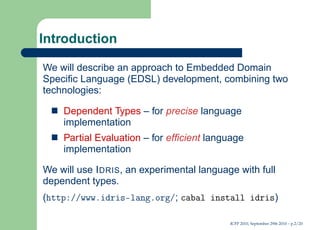Scrapping Your Inefficient Engine
- 1. Scrapping Your InefïŽcient Engine Using Partial Evaluation to Improve Domain SpeciïŽc Language Implementation Edwin Brady and Kevin Hammond eb@cs.st-andrews.ac.uk University of St Andrews ICFP 2010, September 29th 2010 ICFP 2010, September 29th 2010 â p.1/20
- 2. Introduction We will describe an approach to Embedded Domain SpeciïŽc Language (EDSL) development, combining two technologies: Dependent Types â for precise language implementation Partial Evaluation â for efïŽcient language implementation We will use I DRIS, an experimental language with full dependent types. (http://www.idris-lang.org/; cabal install idris) ICFP 2010, September 29th 2010 â p.2/20
- 3. Some Idris Features I DRIS has several features to help support EDSL implementation. . . Full-Spectrum Dependent Types Compile-time evaluation EfïŽcient executable code, via C UniïŽcation (type/argument inference) Plugin decision procedures Overloadable do-notation, idiom brackets Simple foreign function interface . . . and I try to be responsive to feature requests! ICFP 2010, September 29th 2010 â p.3/20
- 4. A Recipe for EDSLs Our motivation is a desire to reason about extra-functional properties of resource-aware programs. The recipe is: 1. Design an EDSL which guarantees the resource constraints, represented as a dependent type 2. Implement the interpreter for that EDSL 3. Specialise the interpreter for concrete EDSL programs, using a partial evaluator To illustrate this, we present a simple implementation of a reliable (ARQ) network transport protocol. ICFP 2010, September 29th 2010 â p.4/20
- 5. Session State ICFP 2010, September 29th 2010 â p.5/20
- 6. Transmission State ICFP 2010, September 29th 2010 â p.6/20
- 7. Network Protocol EDSL data ARQ : State -> State -> Set -> Set where START : ARQ CLOSED OPENING () | START_RECV_ACK : (if_ok : ARQ (OPEN (Ready First)) stâ t) - (on_timeout : ARQ OPENING stâ t) -> ARQ OPENING stâ t | END : ARQ (OPEN (Ready n)) CLOSING () | END_RETRY : ARQ CLOSING CLOSING () | END_RECV_ACK : (if_ok: ARQ CLOSED stâ t) -> (on_timeout: ARQ CLOSING stâ t) -> ARQ CLOSING stâ t ... ICFP 2010, September 29th 2010 â p.7/20
- 8. Network Protocol EDSL data ARQ : State -> State -> Set -> Set where ... | WITHIN : Time -> (action : ARQ st stâ t) -> (on_timeout : ARQ st stâ t) -> ARQ st stâ t | IF : Bool -> (if_true : ARQ st stâ t) -> (if_false : ARQ st stâ t) -> ARQ st stâ t | RETURN : t -> ARQ st st t | BIND : ARQ st stâ t -> (k : t -> ARQ stâ stââ tâ) -> ARQ st stââ tâ; ICFP 2010, September 29th 2010 â p.8/20
- 9. Network Protocol EDSL Interpreter The interpreter for ARQ is parameterised over the actual network data, and keeps track of time to check for timeouts. params (s:Socket, host:String, port:Int) { interpBy : Time -> (prog:ARQ st stâ t) [static] -> IO (Maybe t); ... interpBy t END = checkTime t (sendPacket s host port (CTL S_BYE)); ... } checkTime : Time -> (IO t) -> IO (Maybe t); ICFP 2010, September 29th 2010 â p.9/20
- 10. Sending Packets An example program, which opens a connection, sends a batch of packets, then closes it, within i microseconds: sendNumber : Time -> Nat -> ARQ CLOSED CLOSED (); sendNumber i tot = WITHIN i (do { open_connection 500000; session 500000 O tot First; close_connection 500000; (TRACE "Timed out"); The types ensure that the protocol is followed; any protocol violation is a type error. ICFP 2010, September 29th 2010 â p.10/20
- 11. Sending Packets The following function sends tot packets, with no payload, with timeout i per packet. session : Time -> Nat -> Nat -> (sq:Seq) -> ARQ (OPEN (Ready sq)) CLOSING (); session i n tot sq = IF (n == tot) END (do { TRACE ("Sending " ++ showNat n); send sq i; session i (S n) tot (Next sq); }); This program is recursive and not obviously terminating. ICFP 2010, September 29th 2010 â p.11/20
- 12. Sending Packets (Specialised) Partial evaluation of the ARQ interpreter with this program yields: sessionS : Socket -> String -> Int -> Time -> Time -> Nat -> Nat -> Seq -> IO (Maybe ()); sessionS s h p t i n tot sq = do { checkTime t (if (n == tot) then checkTime t (sendPacket s h p (CTL S_BYE)) else do { putStr ("Sending " ++ showNat n); checkTime t (sendS s h p t sq i); checkTime t (sessionS s h p t (S n) i tot (Next sq))); } ICFP 2010, September 29th 2010 â p.12/20
- 13. Partial Evaluation In order to achieve this result, we: Changed the evaluator to allow caching of intermediate results Cache intermediate results for functions with declared static arguments This speciïŽcally prevents inïŽnite unfolding of recursive calls Host languageâs job â details in the paper Followed some clearly deïŽned guidelines when implementing the interpreter EDSL developerâs job â details in the paper ICFP 2010, September 29th 2010 â p.13/20
- 14. Results Run time, in seconds of user time, for a variety of DSL programs: Program Spec Gen Java C fact1 0.017 8.598 0.081 0.007 fact2 1.650 877.2 1.937 0.653 sumlist 3.181 1148.0 4.413 0.346 copy 0.589 1.974 1.770 0.564 copy_dynamic 0.507 1.763 1.673 0.512 copy_store 1.705 7.650 3.324 1.159 sort_file 5.205 7.510 2.610 1.728 ARQ 0.751 0.990 â â ICFP 2010, September 29th 2010 â p.14/20
- 15. Results Run time, in seconds of user time, for a variety of DSL programs: Program Spec Gen Java C fact1 0.017 8.598 0.081 0.007 fact2 1.650 877.2 1.937 0.653 sumlist 3.181 1148.0 4.413 0.346 copy 0.589 1.974 1.770 0.564 copy_dynamic 0.507 1.763 1.673 0.512 copy_store 1.705 7.650 3.324 1.159 sort_file 5.205 7.510 2.610 1.728 ARQ 0.751 0.990 â â ICFP 2010, September 29th 2010 â p.15/20
- 16. Results Run time, in seconds of user time, for a variety of DSL programs: Program Spec Gen Java C fact1 0.017 8.598 0.081 0.007 fact2 1.650 877.2 1.937 0.653 sumlist 3.181 1148.0 4.413 0.346 copy 0.589 1.974 1.770 0.564 copy_dynamic 0.507 1.763 1.673 0.512 copy_store 1.705 7.650 3.324 1.159 sort_file 5.205 7.510 2.610 1.728 ARQ 0.751 0.990 â â ICFP 2010, September 29th 2010 â p.16/20
- 17. Conclusions I DRISâs type system occupies a âsweet spotâ where partial evaluation is particularly effective. Tagless interpreters Existing evaluator; only minor changes required Comparable performance to hand written C/Java . . . . . . but veriïŽed resource usage, via EDSLs This is not unique to I DRIS! Techniques equally applicable to Agda, Coq, Guru, Trellys, Haskell (with GADTs). . . ICFP 2010, September 29th 2010 â p.17/20
- 18. . . . and ïŽnally I have been packaging and documenting I DRIS. Please give it a go! cabal install idris http://www.idris-lang.org/ http://www.idris-lang.org/tutorial/ Thank you for your attention. ICFP 2010, September 29th 2010 â p.18/20
- 19. Partial Evaluation â Guidelines An EDSL developer can fully exploit partial evaluation by following these guidelines: 1. Index the EDSL representation by its type 2. The interpreter must only pattern match on the EDSL program to be translated 3. Auxiliary functions which match on dynamic data must not be passed EDSL code 4. Ensure that all of program construction, generation and transformation can be evaluated statically Note: this rules out higher order functions, for the moment! ICFP 2010, September 29th 2010 â p.19/20
- 20. Network Protocol EDSL data ARQ : State -> State -> Set -> Set where ... | SEND : Packet -> ARQ (OPEN (Ready n)) (OPEN (Waiting n)) () | RESEND : Packet -> ARQ (OPEN (Waiting n)) (OPEN (Waiting n)) () | RECV_ACK : (if_ok : ARQ (OPEN (Ready (Next n))) stâ t (on_timeout : ARQ (OPEN (Waiting n)) stâ t) -> ARQ (OPEN (Waiting n)) stâ t ... ICFP 2010, September 29th 2010 â p.20/20









![Network Protocol EDSL Interpreter
The interpreter for ARQ is parameterised over the actual
network data, and keeps track of time to check for
timeouts.
params (s:Socket, host:String, port:Int) {
interpBy : Time -> (prog:ARQ st stâ t) [static] ->
IO (Maybe t);
...
interpBy t END
= checkTime t (sendPacket s host port (CTL S_BYE));
...
}
checkTime : Time -> (IO t) -> IO (Maybe t);
ICFP 2010, September 29th 2010 â p.9/20](https://image.slidesharecdn.com/icfp10-100929165445-phpapp02/85/Scrapping-Your-Inefficient-Engine-9-320.jpg)












![[JavaOne 2011] Models for Concurrent Programming](https://cdn.slidesharecdn.com/ss_thumbnails/24881-modelsforconcurrentprogramming-111019034625-phpapp02-thumbnail.jpg?width=560&fit=bounds)
















































